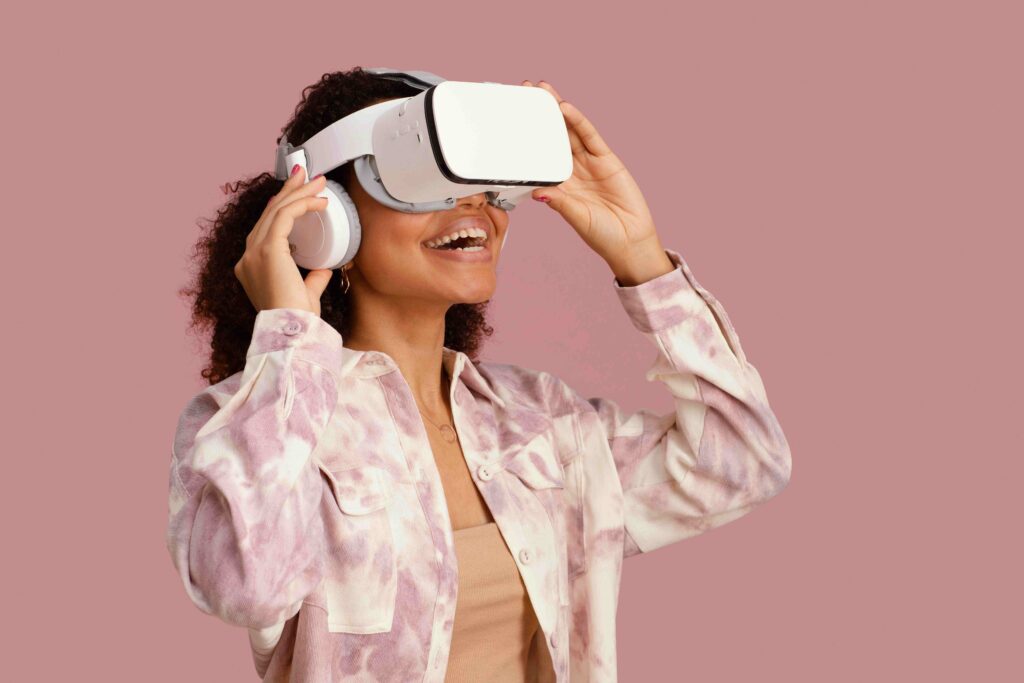Augmented Reality (AR) and Virtual Reality (VR) have transitioned from science fiction fantasies to transformative technologies reshaping our reality. From enhancing immersive experiences to revolutionizing industries, AR and VR development are at the forefront of innovation. Let’s delve into the intricacies of AR and VR development, explore their technology stacks, practical applications, and real-life scenarios where they are making a significant impact.
Defining Augmented Reality (AR) and Virtual Reality (VR) Development
AR overlays digital information onto the physical world, seamlessly blending virtual elements with reality. On the other hand, VR creates immersive environments, transporting users to entirely virtual worlds, detached from physical surroundings. AR and VR development involves creating applications and experiences that leverage these technologies to deliver captivating interactions and experiences.
 Figure 1: Augmented reality |  Figure 2: Virtual reality |
in figure2 : The user is immersed into a virtual environment/virtual reality.
Technology Stacks in AR and VR Development
AR and VR development requires a blend of software and hardware technologies. Commonly used technology stacks include:
- Programming Languages: Unity (C#), Unreal Engine (C++), JavaScript, and HTML5 are popular choices for building AR and VR applications.
- Frameworks and SDKs: ARKit (iOS), ARCore (Android), Vuforia, and Unity3D are essential frameworks and SDKs for AR development. For VR, Oculus SDK, OpenVR, and SteamVR are widely used.
- Hardware: AR development often relies on smartphones and tablets equipped with AR capabilities, while VR development requires specialized headsets like Oculus Rift, HTC Vive, and PlayStation VR.
Practical Applications of AR and VR Development
AR and VR development are already being utilized in real-life scenarios:
- Gaming and Entertainment: Immersive gaming experiences, interactive storytelling, and virtual theme parks.
- Education and Training: Virtual classrooms, interactive simulations, and hands-on training modules.
- Healthcare: Surgical simulations, patient education, and therapeutic interventions.
- Retail and eCommerce: Virtual try-on experiences, interactive product catalogs, and virtual showrooms.
- Architecture and Design: Virtual walkthroughs, 3D modeling, and visualization of architectural projects.
Real-Life Scenarios:
- Training and Simulation: Military and aviation training simulations provide realistic scenarios for trainees to practice.
- Remote Collaboration: Virtual meetings and conferences enable participants to interact in shared virtual spaces.
- Healthcare: Surgeons use AR overlays during surgeries for real-time guidance and visualization.
- Retail: Furniture retailers offer AR apps for customers to visualize how products will look in their homes.
Apple Vision Pro and Oculus
Apple Inc. (2023, June). Introducing Apple Vision Pro . Retrieved from https://www.apple.com/newsroom/2023/06/introducing-apple-vision-pro/
Apple’s ARKit and Oculus VR are prominent players in the AR and VR landscape. ARKit powers AR experiences on iOS devices, while Oculus offers high-quality VR hardware and software, including the Oculus Rift and Oculus Quest headsets.
Future Prospects
As technology continues to evolve, the future of AR and VR development holds immense promise. Advancements in hardware, software, and content creation tools will drive further innovation, leading to more immersive and impactful experiences. With AR and VR becoming increasingly accessible and integrated into everyday life, the possibilities are limitless.
In conclusion, Augmented Reality (AR) and Virtual Reality (VR) development represent the convergence of digital and physical worlds, offering endless opportunities for creativity, innovation, and exploration. As these technologies continue to mature, their impact on society, industry, and human experiences will be profound, shaping the future of how we perceive and interact with the world around us.

